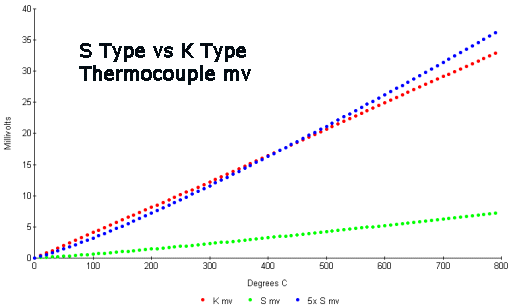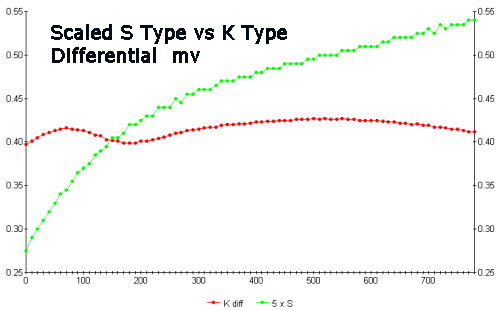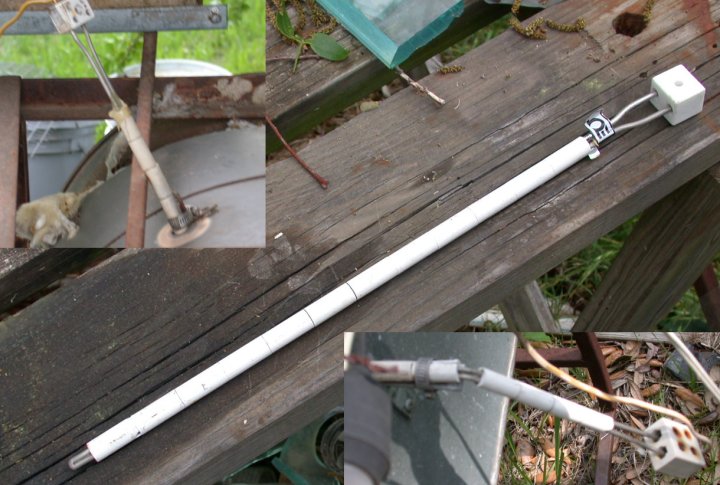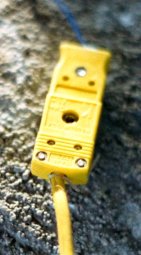|
 VOLTAGE
OUTPUT - Thermocouples put out varying voltages with temperature and the
change over each ten degrees also changes. For this reason, some kind of
conversion must be done or the temperature reading will only be approximate.
Also, wiring must be carefully done because the voltages are small. VOLTAGE
OUTPUT - Thermocouples put out varying voltages with temperature and the
change over each ten degrees also changes. For this reason, some kind of
conversion must be done or the temperature reading will only be approximate.
Also, wiring must be carefully done because the voltages are small.
K & S type thermocouples are defined above.
The upper graph shows the line of millivolts vs. temperature in Celsius.
The red line is a K type. The green line is S type. S type output is about
1/5th K type. The blue line is S multiplied by 5 to show the different
shape of the curves.
 The
lower graph shows the difference in mv at each 10 degrees with the S type
multiplied by 5. The K type is much closer to level, but has a funny
little dip at roughly 190C. The S type has constantly increasing millivolt
output for each 10 degrees. 2005-04-20 The
lower graph shows the difference in mv at each 10 degrees with the S type
multiplied by 5. The K type is much closer to level, but has a funny
little dip at roughly 190C. The S type has constantly increasing millivolt
output for each 10 degrees. 2005-04-20
|
|
METERS - In order to measure
temperatures, I looked at analog and digital pyrometers. Analog
uses a dial with a moving needle, while digital displays digits (numbers.) Less
expensive analog meters with little adjustment can be used with K-type at the
temps of annealing, sagging and fusing because of the levelness of the curve
above.
I chose digital for convenience and accuracy and durability,
since reading most analog displays to closer than ten or twenty
degrees is guessing after squinting at the needle if it hasn't
broken when dropped. I looked at dedicated temperature
measurement units as well as adapters. I decided to buy an
adapter that uses a digital voltmeter for the display. [This is early. I
have also bought volt meters with K type temp reading, which have come down
considerably in price, to $39.99, as time has passed. And a K-type C only for
$29.99
here 2004-01-08]
In 2010, looking around, a number of voltmeters have added thermocouple
reading capability either with K-Type mini-jacks on the meter or through the
banana jacks. To allow the common mini-plugs to use the latter, adaptors
have become available such as the
Fluke 80-AK-A and other brands without the shrouded plugs. 2010-12-05
Costing less than the cheapest digital thermometers, but more than analog,
the adapter includes amplification and compensation so the reading in millivolts
is equal to temperature and the voltage is read with a cheap voltmeter. A single
purpose temperature meter is about $110. I use the adapter with the lowest
cost Radio Shack Digital Voltmeter ($17 on sale.) One adaptor still available is
the
Fluke Thermocouple Converter 80TK
[2001-08-16
Omega www.omega.com has come
out with an $88 analog to voltage adaptor SMCJ-K which connects
to some meters by directly plugging into the meter's banana
jacks, but needs an adaptor for cheaper ones. Omega also has a
neat, but $249, talking DMM
with 2 K-type inputs.] another
product] [2005-03-10 More recently, meters costing as little as $39.99
have come on the market - on sale - with a K-type jack. 2005-03-10]
Note that it is also possible to build your own converter
using a chip sold by Analog Devices which is discussed here.
The TA-1A adapter [no longer available] comes with a thin bead K-type probe rated to
1400F, except that the Teflon insulation is only rated to 500F. I
started using it for testing (and eventually ruined the
insulation) while waiting for more serious thermocouples. If only
the tip is touched to 1400F presumably it would work. For higher
temperature work, a TC made of 16 or 14 gauge wire has a higher
rating. Since the thermocouple voltage is created along the
temperature gradient, the connection at the tip only has to be
okay, not perfect and broken thermocouples can be welded.
Following a suggestion from someone at Spruce Pine Batch, I
ordered $8.50 [now $16] K-type probes from A.R.T. Studio Clay Co. [which is also
a source for the large wire porcelain terminal blocks that mount on the
thermocouple wires, that Omega does not sell with their heavy TC. 2004--01-08]
Neither Grainger nor A.R.T. carry K thermocouple wire separately,
so I ordered that for $8.50 for 6' from Seattle Pottery Supply.
The adapter uses (as do as most digital thermometers) a standard
mini-connector, $7 for 2 from Grainger. For a thermocouple to
work most accurately, all the wiring and all the connections
should match the metals in the thermocouple. That is why special
wire and connectors are needed. Wire and connectors are also
available from Omega. [a much better source, 1-800-826-6342]
|
|
WIRING NOTE - Many places mention the need
for care in wiring and switching but it takes some digging to
understand how much care is needed and why. The why is that the
thermocouple effect produces small voltages (21.493 mv is
specified for 540C, 44.439 mv for 1080C - that's 0.044439 volts)
so that it is easy to mess up the reading if other voltages are
created. Connecting thermocouple wire to copper produces a new
junction. How to avoid the problem? Keep all the pairs of new
junctions at the same temp. At ultra precise labs, this is done
with thermal junction blocks. In more practical situations, it is
likely that the left-hand terminals of a switch or relay are not
much different in temp than those on the right. So, if
thermocouple wire is connected to a switch (copper or alloy) and
a junction is created, the reverse junction is created at the
output a fraction of an inch away and the effect is canceled.
This clearly does not apply if the iron in the thermocouple is
connected to copper wire which is then run several feet (or more)
and connected to iron wire again. Thus, special connectors and
wires are available, but special switches are in short supply.
Now that I have used the adapter, and the least expensive
digital voltmeter from Radio Shack, for some time, I have found
it stable and reliable. I have compared its readings with cones
and other thermometers and checked the reproducibility of the
readings.
The error specified for type K from 559F to 2282 F (293C-1250C)
is 0.75% (while R is .25% and is more stable.) 0.75% is a small
number, but taken times a large number produces a moderate
number, in this case 15F degrees of error at 2000F.
"Iron rusts at low temperatures where condensation can
form. Type K (nickel-chromium (Chromel) vs nickel- aluminum (Alumel))
can be used up to 2,300°F in an oxidizing or inert atmosphere. Type
K thermocouples exhibit a number of instabilities and
inaccuracies, particularly at higher temperatures, changing their
emf/temperature characteristics. In reducing atmospheres (lack of
oxygen) at temperatures of 1,500 to 1,750°F the positive
thermo-element forms a greenish chromic oxide, commonly known as
"green rot". This causes a decrease in the
electromotive force of the thermocouple. Type K is
also subject to aging when exposed to 800 to 1,200°F for a few
hours. Temperature cycling above 1,400°F and then below 700°F
causes a random error due to changes in the composition (inter-granular
structure) of the conductors. " http://www.isa.org/~sarni/temper.pdf.
|
FLAME DETECTOR - When plain wire is heated
at one point, the thermocouple effects in each direction cancel.
If one could imagine somehow making a metal free connection at
the hot point of the wire, one could get the thermocouple effect
of just one kind of wire between the connection and the end of
the wire. It turns out exactly that this can and is done in one kind of flame
detector.
In a furnace, it is often important to detect if the flame has
actually ignited, so the furnace does not fill with an explosive
collection of gas and air. One way this is done is to put the end of a thermocouple wire into the place where the flame is supposed
to be. A hot flame is ionized, so it will conduct. So a voltage
can be created between a metal part of the burner head and the wire. A sensitive circuit can
detect the voltage, or failing to find it, shut down the gas
supply. 2001-08-27, 2009-05-27
Thermocouple question
Posted By: Brody brodyshawglass@charter.net
Date: 2/25/2001 - 1:58 p.m.
Hello one and all! Just a quick question...What's the life
expectancy of a K type thermo in a furnace? Now before everyone
shoots off at me, hear (or read) me out. First I know it's gonna
fry. But in how long? 10 sec, 30 sec, maybe a minute or two? I'm
trying to get a temp. reading on my furnace, and looked over at
an old kiln with a pyrometer on it. And thought I might be able
to use it for a "spot" type reading of the temp. I was
thinking of using a glove and holding it just inside of the door,
MOMENTARILY. Like maybe 20-30 secs max. Will this work, or am I
just kinda foolin' myself? Thanks for the answers (go nice!) -Brody
The problem with K type thermocouples is not how long they
will last. I have a couple that I have had in my gloryhole for
hours at a time and they survive quite well thank you. They are
big wire - 8-11 gauge. Small wire will oxidize rather quickly and
be damaged to the breaking point.
The problem everyone talks about is that they drift and become
more inaccurate. My bone of contention is "How much do they
drift and how inaccurate?" The answer turns out to be about
10-20 degrees. For people who are trying to do precision work,
this is too much. For furnace workers, it is less than the
variation from putting the thing in various locations.
A real problem is that for big wire thermocouples, the time it
takes to make a measurement is looooonnnnng. Your hand (or glove)
will fry if you try to hold it. Long is 20-30 seconds before
settling. Also, if the thermocouple has porcelain insulators as
mine do, you can crack them off by heating too fast. You would need to
ease it into place.
--
Mike Firth
|



 The
lower graph shows the difference in mv at each 10 degrees with the S type
multiplied by 5. The K type is much closer to level, but has a funny
little dip at roughly 190C. The S type has constantly increasing millivolt
output for each 10 degrees. 2005-04-20
The
lower graph shows the difference in mv at each 10 degrees with the S type
multiplied by 5. The K type is much closer to level, but has a funny
little dip at roughly 190C. The S type has constantly increasing millivolt
output for each 10 degrees. 2005-04-20